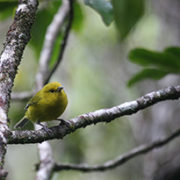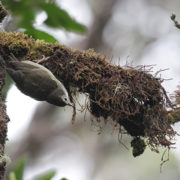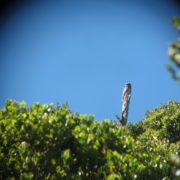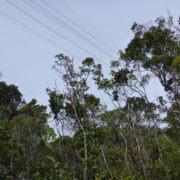The Battle for Nest Material-‘Anianiau vs. ‘Akeke’e
The Battle for Nest Material-‘Anianiau vs. ‘Akeke’e
(from the notebook of seasonal volunteer Laura Southcott)
This morning, I was checking one of our ‘Akikiki nests and some nearby ‘Elepaio nests close to Halehaha Stream. As I finished up and prepared to go look for new nests, I saw a solitary ‘Akeke’e fly by heading back towards camp. I tried to follow it but I really didn’t have a chance – it was gone. So I turned back up the trail and continued looking for nests. Much to my surprise, within half an hour I had spotted what looked like a nest about nine metres off the ground in an ‘ohia tree. It was large, especially compared to the little ‘Elepaio nests we’ve been finding so often, and shaped a little bit like a waffle cone. I lifted my binoculars just in time to see an ‘Akeke’e jumping into it! ‘Akeke’e nests are supposed to be difficult to find because the birds can be secretive and hard to follow, but this nest was easily visible from the trail. When the bird flew away I decided to stay and wait for the bird to come back to make sure that I had identified it correctly and to determine whether it was still building the nest.
After about ten minutes, a bird arrived. It perched below the nest for a while, and to my dismay it was clearly a male ‘Anianiau. Worse, it had nothing in its beak, so I began to think it might be dismantling an old nest to build its new one. After the bird left I decided to wait for another visit to confirm my suspicions. Then perhaps I could follow the ‘Anianiau to its new nest.
In another twenty minutes, the male ‘Anianiau came back, hopped into the nest, grabbed a beakful of nesting material, and flew away again. A minute later a female ‘Anianiau arrived and did the same. I was disappointed that it wasn’t really an ‘Akeke’e nest (and a little upset at my own lack of birding skills!), but I crossed the nest information out of my field notebook, deleted the GPS point, and tried to follow the ‘Anianiau pair. I wasn’t having much luck, though, so I came back to the first nest to see if I could get a better idea of which way they were flying.
When I got there, I could see a bird perched next to the nest out of the corner of my eye, and I thought I saw a deeply forked tail—one of the field marks of the ‘Akeke’e—but I wasn’t holding my breath. I lifted my binoculars again. I was shocked to see that it was, indeed, an ‘Akeke’e, and its beak was full of grass and small twigs! As I watched it hopped into the nest to add this material to it. It seemed that the ‘Anianiaus had been stealing material from this nest even as the ‘Akeke’e was adding it!
I spent the afternoon looking for the ‘Anianiau nest, which turned out to be less than fifty metres away just over a ridge. I quickly dubbed it the Pirate Nest. We will see which birds—the pirate ‘Anianiaus or the ninja-masked ‘Akeke’es—prevail!





 (From the notebook of seasonal volunteer Aaron Hulsey)
(From the notebook of seasonal volunteer Aaron Hulsey)